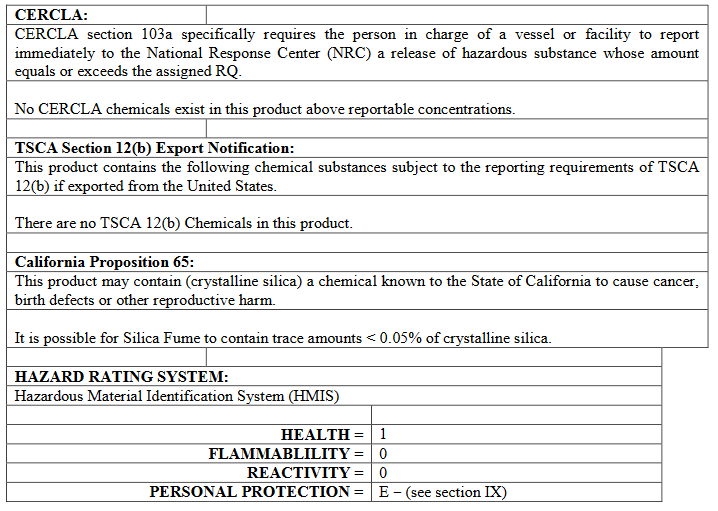MATERIAL SAFETY DATA SHEET
Advanced Cement Technologies Silica Fume (Dry Powder-S)
SECTION I – PRODUCT INFORMATION

EMERGENCY TELEPHONE:CHEMTREC 1-800-424-9300
Synonyms:Amorphous Silica, Silicon Dioxide, Microsilica, Corrochem, Micropoz.
SECTION II – INGREDIENT INFORMATION & EXPOSURE LIMITS

Measured as respirable fraction of the aerosol.
- Silica Fume produced from silicon metal alloys.
- Silica Fume produced from ferro silicon metal alloys.
**Respirable Dust
N.E. Not Established
Other Constituent Materials3:

3.Manufacturer can provide a detailed elemental analysis including other trace elements. The (wt %) values will change if silica fume is from ferro silicon production.
SECTION III – PHYSICAL DATA

*The melting point temperature is dependent on the type of amorphous silica as well as the source.
SECTION IV – STABILITY AND REACTIVITY DATA

SECTION V – FIRE AND EXPLOSION HAZARD DATA

SECTION VI – HEALTH HAZARD IDENTIFICATION DATA
Silica Fume is generally considered a nuisance dust of low toxicity. Use and handling of Silica Fume does not represent a health risk when normal safety rules are observed. Silica Fume when handled and stored in accordance with this document is unlikely to cause harmful effects. It is possible for Silica Fume to contain trace amounts (<0.05%) of crystalline silica, which has been shown to cause silicosis, and has been identified by IARC and NTP as a possible human carcinogen.

SECTION VII – FIRST AID MEASURES

SECTION VIII – SAFE HANDLING AND STORAGE

SECTION IX – EXPOSURE CONTROL & PERSONAL PROTECTION

SECTION X – TOXICOLOGICAL INFORMATION
A. Acute Effects: No data available

B. Chronic Effects:
Silica Fume is generally considered a nuisance dust of low toxicity consequently it is considered to pose minimal risk of pulmonary fibrosis (silicosis). Avoid prolonged exposure to silica fume dust concentrations above the recommended exposure limits, unless the protective equipment is used.
It is possible for Silica Fume to contain trace amounts (<0.05%) of crystalline silica, which has been shown to cause silicosis, and has been identified by IARC and NTP as a possible human carcinogen.
SECTION X –TOXICOLOGICAL INFORMATION (Con’t.)
B. Chronic Effects (Con’t.):
Heating Silica Fume at temperatures above 500ºC (930ºF) for prolonged time periods will convert amorphous silica to the crystalline phases Cristobalite and Tridymite that may cause silicosis. Increased temperatures will increase the formation rate of these phases.
SECTION XI – ECOLOGICAL INFORMATION
No adverse effects are expected. Silica Fume is not considered dangerous to the environment.
SECTION XII – ACCIDENTAL RELEASE & DISPOSAL CONSIDERATIONS

SECTION XIII – TRANSPORTATION INFORMATION

SECTION XIV – REGULATORY INFORMATION

SECTION XIV –REGULATORY INFORMATION (Con’t.)

SECTION XV – ADDITIONAL INFORMATION
All information, recommendations, and suggestions in this MSDS, concerning our products are based on tests and data believed to be reliable, it cannot be guaranteed. Since the actual use by others is beyond our control it is the user’s responsibility to determine the safety, toxicity and suitability for their own use of the product described herein.
